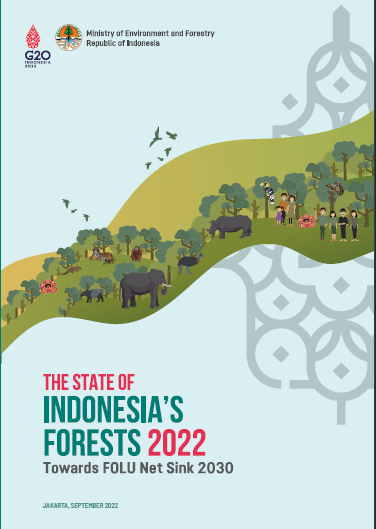THE STATE OF INDONESIA’S FORESTS 2022 Towards FOLU Net Sink 2030
In the wake of the 2018 publication of “The State of the World’s Forests 2018” initiated by the Food and Agriculture Organization of the United Nations (FAO), Indonesia published its first biennial report entitled “The State of the Indonesia’s Forests 2018” which showed the Government’s concern to protect Indonesia’s tropical forests. The first edition of the publication was then updated in 2020 by the publication of “The State of Indonesia’s Forests 2020” reflecting the Government of Indonesia’s commitment to communicating the way Indonesia’s forests were managed, not only for the national interests but also as a contribution to the global community.
The State of Indonesia’s Forests 2022 highlights the important role of Indonesia’s tropical forests in tackling global climate change. As stated in the NDC, the Government has committed to reducing GHG emissions by 29 percent against business-as-usual (BAU) scenario through its own efforts (unconditional) and up to 41 percent with necessary international assistance (conditional) by 2030, in order to reduce climate change-related risks. Of the 29 percent unconditional target, 17.2 percent will be achieved through the forestry sector.
An enhanced NDC document has been submitted to UNFCCC to reflect raising ambition by increasing emission reduction target from 29 percent in the First and Updated NDCs to 31.89 percent unconditionally and, from 41 percent in the First and Updated NDCs to 43.20 percent conditionally. This Enhanced NDC is the transition towards Indonesia’s Second NDC which will be aligned with the Long-Term Low Carbon and Climate Resilience Strategy (LTS-LCCR) 2050 with a Bvision to achieve net-zero emission. Moreover, it provides updates to reflect the current national context, clear milestones along with national development for the period 2020- 2024.
Furthermore, in Indonesia’s Long- Term Strategy for Low Carbon and Climate Resilience 2050 (LTS-LCCR), the Government envisages achieving the Forestry and Other Land Use Net Carbon Sink by 2030, referred to as FOLU Net Sink 2030. It is a set of strategic measures to reduce around 140 million tons of CO2e by 2030 from the FOLU sector that have been successfully prepared and now started to be implemented on the ground.
Indonesia’s FOLU Net Sink 2030 builds on outstanding emission reduction performance in the field. The performance is determined through several factors including the efforts to control forest and land fires, the Permanent moratorium on primary forests and peatlands, the development of weather modification techniques, the efforts of rehabilitation and reforestation, the successful replication of the ecosystem and eco-riparian rehabilitation, the development of urban green spaces, the demarcation of protected areas and HCVF within concession areas, the efforts to cope with habitat fragmentation, and the efforts to strengthen law enforcement. All of these combined measures significantly reduced deforestation in the period 2019-2021. Moreover, Indonesia’s FOLU Net Sink 2030 has become an inspiring model for the international community, and has been the central message of President Joko Widodo on several occasions, focusing on real work that can be publicly verified. It systematically organizes actions to reach the net sink target, strengthened by predicted measurement of carbon emission reduction, and then set to be fully implemented on the ground.
This publication was prepared by a collaborating team from several directorates under the Ministry of Environment and
Forestry and the Peatlands and Mangrove Restoration Agency, presenting the up-to-date data and information on the management of Indonesia’s tropical forests while illustrating the progress that has been made so far. This book presents the policies and technical highlights in the forestry sector taken by the Government of Indonesia towards the FOLU Net Sink 2030.
I express my gratitude to all those who have contributed to and actively participated in updating the State of Indonesia’s Forests 2022; members of the writing team, all editors involved, and contributors from the private sector. I also appreciate the Food and Agriculture Organization of the United Nations (FAO) and the Association of Indonesian Forest Concessionaires (APHI) for their consistent supports in the publication of the State of Indonesia’s Forests 2022.
Jakarta, September 2022.
Jakarta, September 2022
The Minister of Environment and Forestry
SITI NURBAYA
visibility View File
